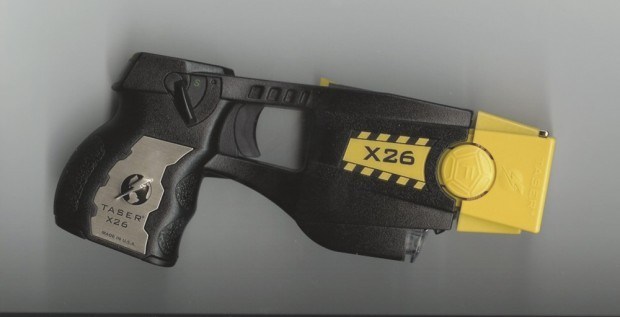LIHU‘E — While most seem to agree that various levels of force are necessary for police to protect themselves and the public from potentially dangerous people and situations, there is disagreement on if, how and when electric stun guns should
LIHU‘E — While most seem to agree that various levels of force are necessary for police to protect themselves and the public from potentially dangerous people and situations, there is disagreement on if, how and when electric stun guns should be used.
The Kaua‘i Police Department’s electric gun policy, pertaining to the Taser brand many officers carry, states, in part, “The Taser should only be used against persons who are actively resisting or exhibiting active aggression.”
While that seems to be the case in the Jan. 20 arrest of Tyson Yadao, who was Tasered while allegedly kicking KPD officers trying to arrest him in Hanama‘ulu, it isn’t quite as clear regarding the arrest of LeBeau Lagmay in November 2009. (See page A7 for the latest on the Yadao case.)
Police officers stated in court that Lagmay, after being Tasered the first of three times, was face down on the ground with his arms underneath him, apparently refusing to allow his arms to be placed behind his back for handcuffing. He was then Tasered two more times before he finally allowed officers to handcuff him for terroristic threatening and other charges.
Officers said in court that he allegedly threatened to kill police officers. Lagmay pleaded not guilty to all charges.
Requests by The Garden Island to view the Taser video of the Lagmay incident — queries were made to both KPD and state Deputy Public Defender Edmund Acoba, who represents Lagmay in his criminal case — have been denied.
Acoba said the video could only be viewed if and when it is offered as evidence in Lagmay’s criminal case, and KPD Chief Darryl Perry said “the main reason that we cannot release the video at this point is because the case has yet to be adjudicated.”
Perry also said that, because the case is still moving in 5th Circuit Court before Judge Randal Valenciano, he could not answer questions about whether he had viewed the video, whether the Taser use in the Lagmay arrest abides by the KPD electric gun policy (general order), and whether the second and third cycles of the Taser were necessary because Lagmay was still considered to be “actively resisting.”
Under the KPD electric gun policy (available in its entirety at www.thegardenisland.com), “actively resisting” is defined as “physically evasive movements to defeat an officer’s attempt at control, including bracing, tensing, pushing or verbally signaling an intention to avoid or prevent being taken into or retained in custody.”
Lagmay’s jury trial, scheduled to have begun Monday, was continued to April 12.
Yadao has several court appearances for pleas this week on various cases.
Lagmay was originally charged with 18 crimes (11 of them first-degree terroristic threatening), but the number of charges was reduced to six when Lagmay’s case was brought before 5th District Judge Trudy Senda during his preliminary hearing.
The remaining charges include three counts of first-degree terroristic threatening, resisting arrest, operating a motor vehicle while under the influence of an intoxicant (liquor), and having an open liquor container in a vehicle while operating it. A charge of highway racing was dismissed.
Based on a description of the Lagmay arrest, Jon Van Dyke, a professor of constitutional law at the University of Hawai‘i at Manoa, said it appears to him that the Taser use in the Lagmay arrest was an excessive use of force.
“That certainly seems grossly excessive. You’d think there’d be some kind of in-between thing” that could have been used by officers to subdue Lagmay, said Van Dyke, who has been teaching at UH-Manoa for 34 years.
Van Dyke said that, in both the Lagmay and Yadao cases, if three or more officers responded, they “likely had the opportunity to take the guy without the Taser.
“Proportionality is always the key in these cases. If someone is threatening my life, I am allowed to kill that person,” said Van Dyke.
There are times and places where Taser use is appropriate, and other times the weapons may be misused, he said.
“Obviously the use of force must be proportional, and Tasers can be misused. On the other hand, they are probably better than bullets in appropriate cases,” said Van Dyke.
Kaua‘i police officers, and other law-enforcement personnel, need to have a range of available weapons and options, from mild to intermediate to deadly force, Van Dyke said.
Proper training is essential, he said.
There is probably a proper role for the Taser and it may save lives in some situations, but “it will cost lives if used almost randomly,” said Van Dyke.
Ultimately, it will likely be the courts that decide whether or not KPD’s use of the Taser on Lagmay was excessive use of force.
While a Hawai‘i state appeals court recently ruled that a Maui Police Department officer’s use of a Taser on a female subject in a domestic-disturbance arrest did not rise to the point of excessive use of force, a California case appealed to the 9th Circuit Court involving a Taser used on a man during a traffic stop did rise to the level of excessive, that court ruled.
In Bryan v. McPherson, the 9th Circuit Court ruled “use of the Taser was unconstitutionally excessive and a violation of Bryan’s clearly established rights,” and that law-enforcement personnel must “balance the amount of force applied against the need for that force.”
The court also ruled “non-lethal” is not synonymous with “non-excessive.” “All force — lethal and non-lethal — must be justified by the need for the specific level of force employed,” the court ruled.
“We agree with the Fourth and Eighth Circuit’s characterization of a Taser shot as a ‘painful and frightening blow.’
“We hold only that the X26 and similar devices constitute an intermediate, significant level of force that must be justified by ‘a strong government interest (that) compels the employment of such force,’” the court ruled.
Van Dyke said the decision “is very clear regarding the need for a proportional response,” meaning the level of police force employed should be proportionate to the aggressiveness of the subject and the officer’s sense of danger.
Despite widespread media reports that the 9th Circuit Court’s decision would mandate that nearly every police department in the country would need to reevaluate its Taser policy, Perry said no such action is necessary regarding KPD’s 13-month-old policy.
“With respect to our Taser policy, the recent 9th Circuit Court of Appeals decision would have no impact on our policy, as we are already in compliance with their recommendations, as we have been from the inception,” said Perry. “We continue to monitor findings and decisions, and will consider modifications to the policy based on empirical evidence by credible sources and/or oversight court decisions. We understand changes are inevitable and we must be ready to respond to these changes to better service the community.”
Jonathan Jay of Kalaheo is a community activist who is using the appellate decision as impetus for changes in levels of force employed by KPD.
“Together we can successfully assist our KPD to make reasonable and responsible reform, limit liability and enhance officer and citizen safety,” he said.
“As many have long been advocating a more conservative approach re: Tasers, the recent unanimous 9th Circuit Court ruling fundamentally reshapes the national landscape under which police officers can deploy Tasers, and will force many departments to re-design and curtail their Taser policies to become more safe, more sane and more limited,” said Jay, calling for “a full-court press” for reform on Kaua‘i.
The entire appellate court decision is at www.ca9.uscourts.gov/datastore/opinions/2009/12/28/08-55622.pdf.



